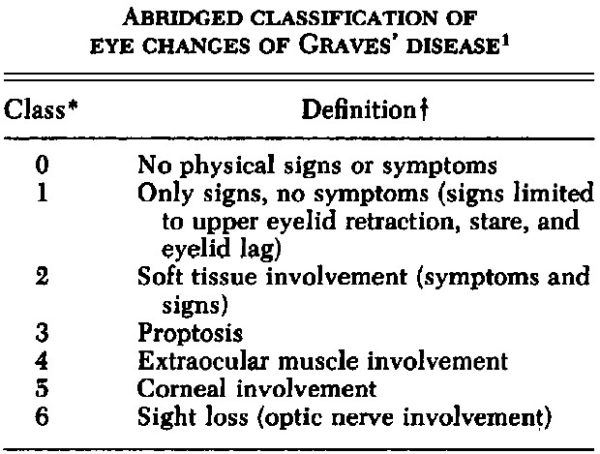Graves Ophthalmopathy
Eponymythology: The myths behind the history
Graves Ophthalmopathy: constellation of findings, apparent in 25-50% of patients with Graves disease.
- Pathopysiology: oedema and lymphocytic infiltration of orbital fat, connective tissue, and eye muscles.
- Clinical symptoms: eye discomfort, ‘gritty’ eye sensation, excessive lacrimation and diplopia.
- Clinical findings include exophthalmos; eye-lid oedema; eye movement limitation, and conjunctival chemosis/injection.
- Clinical risk: Optic neuropathy – best predicted by lid oedema and limitation of eye movements (NOT proptosis, as intraocular pressure is relieved by the outward protrusion)
History
1835 – Robert James Graves described a clinical spectrum associated with exophthalmic goitre (Graves disease)
1969 – Werner first attempted to classify the changes associated with Graves ophthalmopathy.
1977 – Werner and the American Thyroid Association reviewed and modified the original classification with NO SPECS mnemonic. [1977 May;83(5):725-727]
‘The problem of nomenclature of the eye changes of toxic diffuse goiter (Graves’ disease, Basedow’s disease, Parry’s disease) remains an unsettled one. Descriptive terms have filled the literature and new ones continue to appear…such as endocrine exophthalmos, infiltrative ophthalmopathy, progressive exophthalmos, malignant exophthalmos and so on. ..a committee of the American Thyroid Association finalized, a classification of the eye changes of Graves’ disease.‘ [Werner 1969 Oct;68(4):646-648]
Associated Persons
- Caleb Hillier Parry (1755–1822)
- Robert James Graves (1796–1853) [Graves-Basedow disease]
- Karl Adolph von Basedow (1799–1854) [Graves-Basedow disease]
- John Dalrymple (1803–1852) [Dalrymple sign]
- Karl Stellwag von Carion (1823–1904) [Stellwag sign]
- Albrecht von Graefe (1828-1870) [Graefe sign]
- Paul Julius Möbius (1853-1907) [Möbius sign]
- Alix Joffroy (1844-1908) – [Joffroy sign]
Alternative names
- Eye changes of Graves disease
- Thyroid-associated ophthalmopathy (TAO)
- Thyroid eye disease (TED)
References
- Graves RJ. Newly observed affection of the thyroid gland in females. London Medical and Surgical Journal. 1835;7:516-517
- Werner SC. Classification of the eye changes of Graves’ disease. Am J Ophthalmol. 1969 Oct;68(4):646-648. [PMID 5394450]
- Werner SC. Modification of the classification of the eye changes of Graves’ disease. Am J Ophthalmol. 1977 May;83(5):725-727. [PMID 577380]
- Bartley GB, Fatourechi V, Kadrmas EF, Jacobsen SJ, Ilstrup DM, Garrity JA, Gorman CA. Clinical features of Graves’ ophthalmopathy in an incidence cohort.Am J Ophthalmol. 1996 Mar;121(3):284-90. [PMID 8597271]
- Bartalena L, Tanda ML. Clinical practice. Graves’ ophthalmopathy. N Engl J Med. 2009 Mar 5;360(10):994-1001 [PMID 19264688]
- Feldon SE, Muramatsu S, Weiner JM. Clinical classification of Graves’ ophthalmopathy: identification of risk factors for optic neuropathy. Arch Ophthalmol. 1984;102:1469–1472.
- Cadogan M. Eponymythology: Diffuse Toxic Goitre. LITFL: 2018
- Cadogan M. Eponymythology: Graves Orbitopathy. LITFL: 2018

eponymythology
myths behind the history

